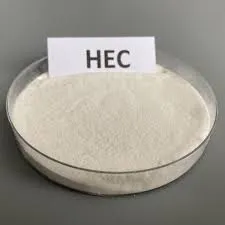
aug . 10, 2024 12:00 Back to list
Overview of Hydroxyethyl Cellulose Production Methodologies and Techniques in Industrial Settings
The Manufacturing Process of Hydroxyethyl Cellulose
Hydroxyethyl cellulose (HEC) is a non-ionic, water-soluble polymer derived from cellulose, a natural polymer that provides strength and structure to plant cell walls. HEC has a wide range of applications, including in the pharmaceutical, cosmetic, and construction industries, owing to its excellent water retention, thickening, and film-forming properties. The manufacturing process of hydroxyethyl cellulose involves several steps, including cellulose sourcing, etherification, purification, and drying.
1. Sourcing Cellulose
The production of HEC begins with the sourcing of cellulose, which is typically extracted from plant materials such as cotton, wood pulp, or other natural cellulose fibers. The purity and quality of cellulose are crucial, as these factors directly influence the properties of the final product. The raw cellulose is first pre-treated to remove impurities, such as lignin and hemicelluloses, which may interfere with the subsequent chemical processes.
2. Etherification
Once purified cellulose has been obtained, it undergoes an etherification process to introduce hydroxyethyl groups. This is primarily achieved through the reaction of cellulose with ethylene oxide in the presence of a catalyst, often a base such as sodium hydroxide. The reaction typically occurs in a controlled environment to ensure that the etherification is uniform and efficient.
The degree of substitution, which refers to the average number of hydroxyethyl groups attached to each cellulose unit, plays a critical role in determining the solubility and viscosity of the resulting HEC. Higher degrees of substitution generally lead to improved thickening and binding capabilities. Manufacturers can control this degree by adjusting the reaction time, temperature, and the concentration of the reagents.
3. Neutralization and Recovery
hydroxyethyl cellulose manufacturing process

After the etherification reaction is complete, the mixture must be neutralized to remove any residual alkaline materials. This step is important as it prevents the formation of undesirable by-products and ensures that the final product is safe for consumption or use in various applications. Neutralization is often achieved through the addition of acids such as hydrochloric acid, which reacts with the alkaline substances and precipitates any unwanted salts.
Following neutralization, the HEC solution is then carefully washed to remove impurities and excess reactants. This may involve several washing steps with water to ensure the purification of the HEC product.
4. Drying and Milling
The purified HEC is then concentrated, often through evaporation, and subsequently dried. Common drying techniques include spray drying or freeze-drying, both of which aim to reduce the moisture content to a level suitable for storage and usability. The drying process is crucial, as excess moisture can lead to degradation of the product and affect its performance.
Once dried, the HEC is typically milled to achieve a desired particle size, which influences its handling and solubility characteristics in applications. This milling process allows for the customization of the HEC product to meet specific requirements based on its intended use.
5. Quality Control
Throughout the manufacturing process, stringent quality control measures are employed to ensure the consistency and performance of the HEC. This includes testing for viscosity, solubility, and microbial contamination, allowing manufacturers to guarantee that their product meets industry standards and customer specifications.
In summary, the manufacturing process of hydroxyethyl cellulose is a complex but well-structured operation that transforms natural cellulose into a versatile polymer with a myriad of applications. Through careful sourcing, chemical modification, purification, and rigorous quality control, manufacturers can produce high-quality HEC tailored to meet the diverse needs of various industries.
-
Why HPMC is a Key Additive in Wall Putty Formulations
NewsAug.05,2025
-
Redispersible Powder in Decorative Renders: Function Meets Finish
NewsAug.05,2025
-
Redispersible Powder for Interior Wall Putty: Smooth Results Every Time
NewsAug.05,2025
-
HPMC’s Water Retention Capacity in Dry Mortar Applications
NewsAug.05,2025
-
HPMC Factory Contributions to Liquid Detergents
NewsAug.05,2025
-
How HPMC Factory Products Change Detergent Textures
NewsAug.05,2025







